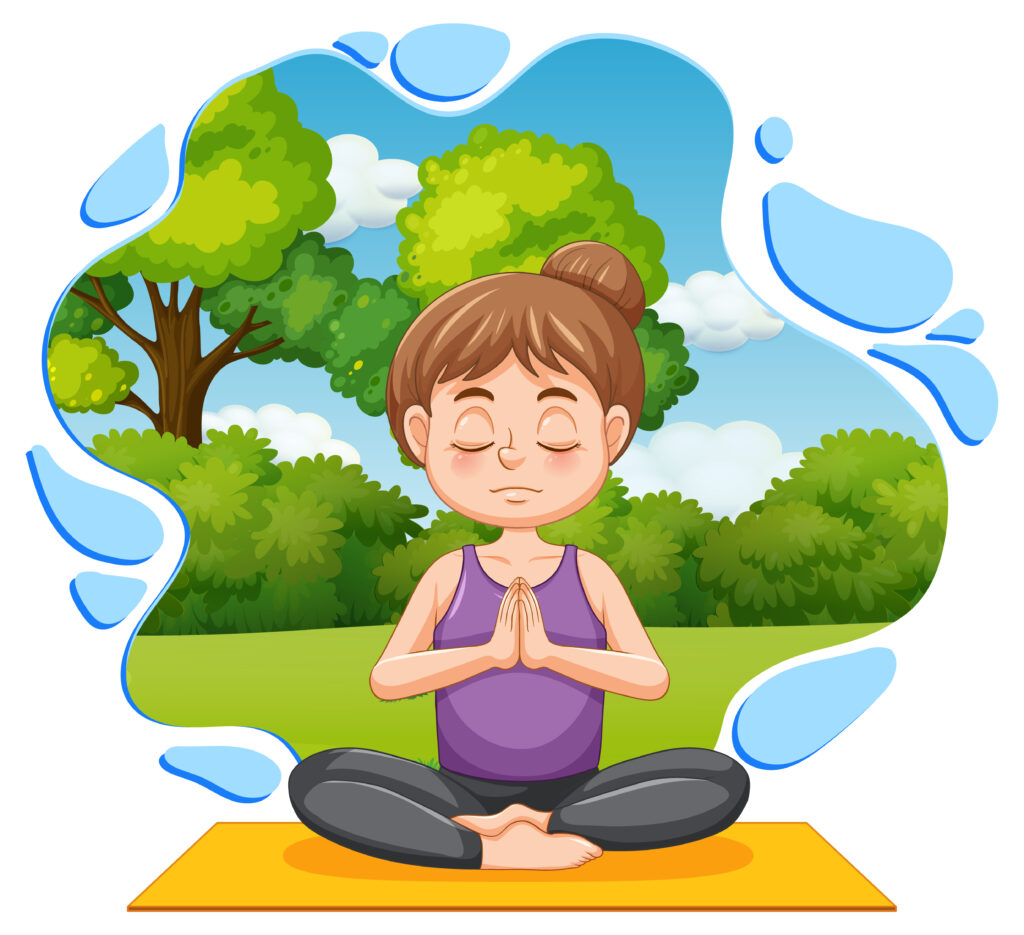What is Mindfulness

Table of Contents
Mindfulness is a mental practice that involves focusing one’s awareness on the present moment while accepting one’s feelings, thoughts, physical sensations, and surrounding environment without judgment. It is often developed through meditation techniques but can also be applied in everyday activities.
The core principles of mindfulness include:
- Present Moment Awareness: Being fully engaged and attentive to what is happening right now, without dwelling on the past or worrying about the future.
- Non-Judgmental Acceptance: Observing thoughts, feelings, and sensations as they arise without labeling them as good or bad, right or wrong. Instead, there is an attitude of openness and curiosity.
- Releasing Attachment: Letting experiences come and go without clinging to them or trying to control them. It involves letting go of expectations and preconceived notions.
- Cultivating Compassion: Developing a compassionate and kind attitude toward self and others, accepting the shared human experience of suffering and happiness.
Mindfulness practices can range from formal meditation sessions to informal practices such as mindful eating, walking, or breathing exercises. Research has shown that regular mindfulness practice can have many benefits for mental and physical well-being, including reducing stress, anxiety, depression, improving focus and concentration, and increasing overall quality of life.
How to Practice Mindfulness
- Mindful breathing: Find a comfortable spot, sit comfortably, and gently close your eyes. Focus on your breath, noticing the sensation of it flowing in and out. Whenever your mind wanders, gently bring it back to the rhythm of your breathing.
- Body Scan: Lie down in a quiet place and allow your awareness to move through your body, starting from your toes to your head. Pay attention to any sensations or tensions without judging them. Simply observe each area and breathe into it.
- Mindful Walking: Take a leisurely walk in a peaceful environment. Pay attention to each step you take, feeling the ground beneath your feet and the gentle movements of your body. Let your senses come alive with the sights, sounds and smells around you.
- Observing Thoughts and Feelings: Sit quietly and watch your thoughts and feelings come and go like clouds in the sky. Instead of getting caught up in them, observe them with a sense of curiosity and acceptance.
- Mindful Eating: Choose a small snack, like a piece of fruit or walnuts. Take some time to appreciate its colors, textures, and aromas. Savor each piece slowly, paying attention to the flavors dancing on your tongue and the sensations in your mouth.
- Daily Mindfulness: Incorporate mindfulness into your daily routine by paying attention to mundane tasks. Whether it’s washing dishes, brushing your teeth, or taking a shower, immerse yourself completely in the experience, focusing on each movement and sensation.
- Mindfulness Meditation: Sit in a comfortable position, perhaps on a pillow or chair. Take a moment to close your eyes gently or soften your gaze. Allow your awareness to naturally focus on your breath, a chosen focal point, or the sensation of your body relaxing. If your mind wanders, gently direct your attention back to the present moment without judgment.
Remember, mindfulness is about being present and engaged in each moment, so approach these practices with a sense of curiosity and kindness toward yourself. With regular practice, you will gradually develop a deeper sense of awareness and peace in your life.
Mindfulness Exercises

- Breathing Meditation: Find a comfortable place to sit quietly, perhaps in a cozy corner or under a favorite tree. Close your eyes gently and allow your attention to focus on the rhythm of your breathing. Notice how it feels as it enters and leaves your body, like the gentle ebb and flow of ocean waves. If your mind wanders, simply direct it back to the sensation of your breath, grounding yourself in the present moment.
- Body Scan: Lie down on a soft surface, feeling support beneath you. Begin to bring your awareness to each part of your body, starting from your toes and moving upward, as if a gentle wave of awareness is coming over you. Notice any areas of tension or relaxation without judgment, simply accept whatever sensations arise. Allow yourself to sink deeper into a state of relaxation as you continue this journey through your body.
- Mindful Eating: Take a moment to choose a piece of fruit or small snack. Hold it in your hand and observe its texture, color and shape. Bring it near your nose and inhale deeply, inhaling its aroma. With conscious intention, take a small bite and enjoy the flavors, letting them dance on your taste buds. Pay attention to the sensations of chewing and swallowing, which are fully present in this moment of nurturing and appreciation.
- Walking Meditation: Step outside into the embrace of nature, feeling the earth beneath your feet and the sun on your skin. As you walk, let your senses become alive to the world around you. Notice the rustling of leaves in the wind, the chirping of birds overhead and the scent of blooming flowers. With each step, feel yourself in the present moment, connected to the beauty and wonder of the world.
- Gratitude Practice: Take a quiet moment to reflect on the blessings in your life, big and small. Perhaps it’s the warmth of a loved one’s smile, the comfort of a cozy blanket, or the simple pleasure of a delicious meal. Let yourself bask in the glow of gratitude, feel a sense of abundance and satisfaction wash over you.
- Exercise the five senses: Take some time to soak in your surroundings. Look around and observe details, paying attention to five things that catch your eye, four textures that you can feel, three sounds that you can hear, two smells that you can recognize, and one taste that you can taste. You can taste. Let this sensory exploration deepen your connection to the present moment.
- Loving-Kindness Meditation: Find a comfortable position and remember someone who holds a special place in your heart. This could be a dear friend, a beloved family member, or even you. Let the feelings of love and compassion flow freely as you silently wish for their well-being and happiness. Spread these wishes outward, embracing all beings with kindness and warmth
Mindfulness Activities
- Mindful Coloring: Grab a coloring book and some colored pencils or markers. Choose a coloring page and focus all your attention on the coloring action. Pay attention to the feel of the pencil or marker in your hand, the colors you are using, and the movement of your hand as you fill in the spaces. Let go of any thoughts or distractions and immerse yourself completely in the activity.
- Cloud Watching: Find a comfortable spot outside, perhaps in a park or in your backyard. Bend over and let your gaze go skyward.
Watch the clouds pass by, paying attention to their size, shape, and movements. Resist the urge to analyze or evaluate the clouds; Instead, just look at them with a sense of curiosity and wonder. - Mindful listening: Choose a piece of calming music or nature sounds to listen to. Take a comfortable sitting or bending position and gently close your eyes. Focus all your attention on the sounds, letting them overwhelm you without trying to change or control them. Pay attention to the different layers of sound, from melodies to underlying rhythms and intonations.
- Mindful Stretching: Take a few minutes to stretch your body, focusing on each movement and sensation. Begin to gently bend the neck, extend the shoulders and extend the arms. Pay attention to how your muscles feel when you stretch them, and breathe deeply with each stretch. It can help release stress and increase awareness of your body.
- Mindful Tea Drinking: Make a cup of your favorite herbal tea. As you prepare the tea, notice the sound of the water boiling, the aroma of the tea leaves, and the warmth of the cup in your hands. Take small sips of the tea, enjoying the flavor and warmth with each sip. Allow yourself to fully engage your senses in the experience.
- Nature Walk: Go for a nature walk, whether it’s to a nearby park, in the woods, or along the beach. Pay attention to the sights, sounds, and smells around you. Pay attention to the colors of the leaves, the rustle of the wind through the trees, and the scent of flowers or pine trees. Take your time and appreciate the beauty of the natural world.
- Mindful Journaling: Set aside some time to write in a journal. Write about your thoughts, feelings, and experiences, allowing you to express whatever comes to mind without judgment. Notice how writing makes you feel and how it helps you process your thoughts and emotions.
Engaging in these mindfulness activities can help foster a higher sense of presence and awareness in your everyday experiences, contributing to peace of mind and overall well-being. Feel free to adapt these activities to your preferences and interests.
Mindfulness Meditation
- Find a comfortable position: Sit in a comfortable position, with your spine comfortably straight but not overly rigid. You can place your hands gently on your thighs or in your lap, whatever feels most natural to you.
- Set a time limit: Set a duration for your meditation session that fits your schedule and allows you to fully engage in the practice. Whether it’s 5 minutes, 10 minutes or more, choose a time frame that feels comfortable and achievable for you.
- Focus on your breathing: Close your eyes or keep them slightly open with a light gaze. Begin by gently directing your awareness to the natural rhythm of your breathing. Feel the slight expansion and contraction of your chest or abdomen with each inhalation and exhalation. Alternatively, focus on the subtle sensation of air flowing in and out through your nostrils. Find a point of focus that feels most comfortable and natural for you, letting your breath guide you into the present moment.
- Accept thoughts and feelings: As you meditate, thoughts, feelings, and sensations will inevitably arise. Instead of trying to suppress them, simply notice them as they come and go, like leaves floating in a stream. Then, gently bring your attention back to the sensation of your breath.
- Be in the present: Whenever you notice your mind wandering, gently bring your attention back to the present moment and the sensation of your breath. You can use a simple anchor like counting your breaths or repeating a mantra to help keep you focused.
- Practice Non-Judgmental Awareness: Throughout your meditation, develop an attitude of acceptance and non-judgment towards whatever arises in your mind and body. Be kind and compassionate to yourself, no matter what thoughts or feelings arise during your practice.
- End with care: When your meditation session is over, take a moment to return to your day-to-day activities. Notice how you feel after meditating and carry that sense of mindfulness and presence with you as you go about your day.
Remember that mindfulness meditation is a skill that takes time and practice to develop. Be patient with yourself and approach each meditation session with openness and curiosity. Over time, you will find that mindfulness meditation brings more peace, clarity, and awareness to your life.
Mindfulness For Kids
Introducing mindfulness to children can be a valuable way to help them develop skills for emotional regulation, focus, and overall well-being. Here are some mindfulness activities designed especially for children:

- Breathing mindfully: Teach children to take deep breaths, inhaling through the nose and exhaling through the mouth. Encourage them to notice the sensation of breath in their lungs as they breathe in and silently count their breaths. This can be done through fun exercises such as “Imagine you are smelling a flower and blowing out a candle.”
- Sensory Awareness: Guide children through activities that engage their senses, such as listening to calming music, feeling different textures (like soft fabric or a rough rock), or a piece of fruit. Taste carefully, paying attention to its taste and texture.
- Mindful Movement: Lead children through simple yoga poses or stretching exercises, encouraging them to focus on the sensations in their bodies as they move. You can also try activities like “mindful walking,” where they pay attention to each step they take and the feeling of their feet touching the ground.
- Imagery and Visualization: Use guided imagery or visualization exercises to help children cultivate a sense of peace and relaxation. For example, guide them to imagine that they are floating on a cloud or relaxing on a peaceful beach, encouraging them to use their imagination to engage all of their senses.
- Mindful Listening: Let children close their eyes and listen carefully to the sounds around them, whether it is the sound of birds chirping, cars passing by, or a household appliance. Let there be a humming sound. Encourage them to pay attention to each sound without judgment, simply observing the time it comes and goes.
- Gratitude Practice: Foster a sense of gratitude by encouraging children to consider things they are grateful for each day. This can be done through a gratitude journal where they write or draw about something positive that happened to them, or through sharing grateful thoughts during a family meal or bedtime routine. Could.
- Mindful Storytelling: Read children’s books or tell stories with a mindfulness theme, such as stories about breathing exercises, dealing with emotions, or appreciating the present moment. After this, you can discuss the story together and ask questions to deepen their understanding.
It’s important to keep mindfulness activities for children engaging and age-appropriate, incorporating elements of play and exploration. By starting these practices early on, children can develop valuable skills for managing stress, building resilience, and promoting a better sense of well-being.

